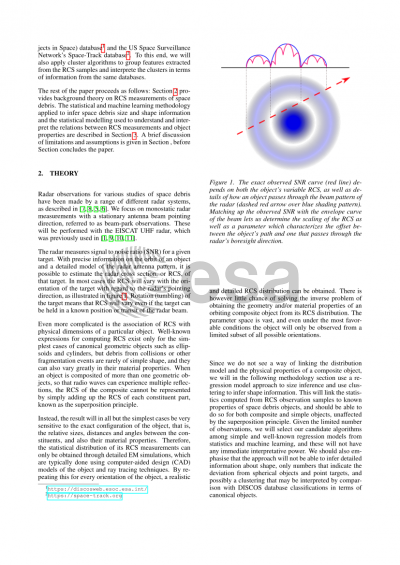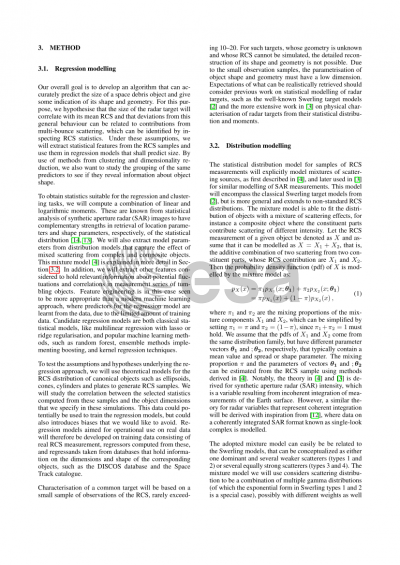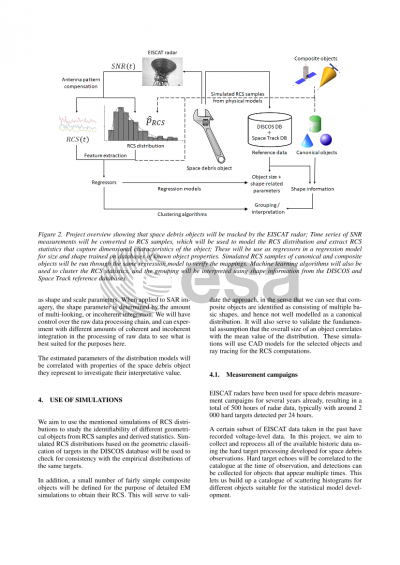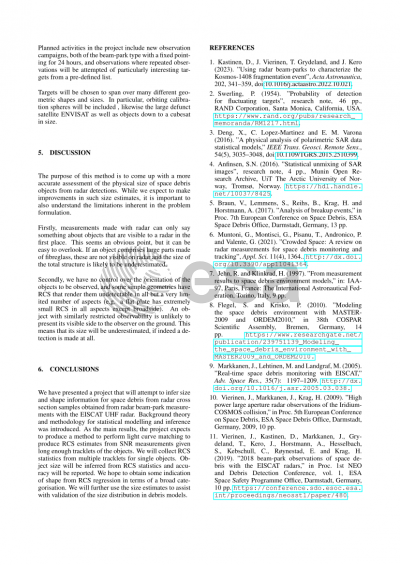Document details

Abstract
Radar Beam-park experiments have been very successful in characterizing the distribution of space debris objects, both in terms of orbital parameters but also in terms of limiting the estimates of their radar cross section, or RCS. A recent paper \[0\] used observed range and range rates to refine orbit estimates by matching up the observed SNR curve to that predicted by simulations. This gives good estimates of RCS for objects whose RCS does not vary rapidly (i.e. that are isotropic or not tumbling).
For assessment of collision risk and avoidance manoeuvering, the physical size of the debris object is the key parameter. This can be directly related to RCS only in cases that are either extremely simple, or modelled in exquisite detail. We will instead infer physical size from the statistical distribution of the RCS estimates made for a single object.
Characterisation of a common target will be based on a small sample of observations of the RCS, most likely 10-20 at most. For such targets, whose geometry is unknown and whose RCS cannot be simulated, the possibilities for detailed reconstruction of its shape and geometry are severely limited. Due to the small observation samples, the parametrisation of object shape and geometry must have a low dimension. Expectations of what can be realistically retrieved should consider previous work on statistical modelling of radar targets, such as the well-known Swerling target models \[1\] and the more extensive work in \[2\] on physical characterisation of radar targets from their statistical distribution and moments.
The latter paper shows that distribution shape and statistical moments do hold information about targets' composition from weak and strong scatterers and their relative contribution. However, successful characterisation of targets in terms of a mixed scatterer model requires computation of logarithmic moments and cumulants, and use of the decomposition theory derived by one of us in \[3\]. The small sample size makes it essential to use the paradigm of logarithmic statistics, as do \[2\] and \[3\], since logarithmic cumulants are near-sufficient statistics for the relevant RCS distribution models and will be needed to obtain best possible accuracy given the small data samples.
We hypothesise that the size of the radar target will correlate with its mean RCS, and that deviations from this general behaviour can be related to heterogeneous contributions from multiple scatterers and identified by inspecting RCS statistics. This can be verified by comparing RCS statistics, estimated with state-of-the-art methods from \[3\], to object characteristics listed in the Space-Track catalogue.
We present the statistical background and preliminary results.
\[0\] Kastinen, D. et al., "Using radar beam-parks to characterize the Kosmos-1408 fragmentation event", Accepted for publication in Acta Astronautica, 2022.
\[1\] Swerling, P. (1954). "Probability of detection for fluctuating targets", ASTIA Document No. AD 80638, research note, 46 pp., RAND Corporation, Santa Monica, California, USA.
\[2\] Deng, X., C. Lopez-Martinez and E. M. Varona, "A physical analysis of polarimetric SAR data statistical models," IEEE Trans. Geosci. Remote Sens., vol. 54, no. 5, pp. 3035-3048, May 2016, doi: 10.1109/TGRS.2015.2510399.
\[3\] Anfinsen, S.N. (2016). "Statistical unmixing of SAR images", research note, 4 pp., Munin Open Research Archive, UiT The Arctic University of Norway, Tromsø, Norway, URL: https://hdl.handle.net/10037/8425.
Preview







